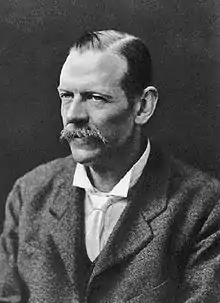George H. Bryan
George Hartley Bryan FRS[1] (1 March 1864 – 13 October 1928) was an English applied mathematician who was an authority on thermodynamics and aeronautics. He was born in Cambridge, and was educated at Peterhouse College, Cambridge, obtaining his BA in 1886 (as 5th wrangler), MA in 1890, and DSc in 1896.[2] He was a professor at University College of North Wales, and is generally credited with developing the modern mathematical treatment of the motion of airplanes in flight as rigid bodies with six degrees of freedom.

Aside from minor differences in notation, Bryan's 1911 equations are the same as those used today to evaluate modern aircraft. (Perhaps surprisingly, Bryan's equations—published just eight years after the first aircraft flew—are most accurate when applied to supersonic jets.) In evaluating aircraft mathematically, Bryan focused on issues of aerodynamic stability rather than on control; stability and control of an aircraft tend to lie on opposite ends of the same spectrum. Bryan's aeronautic results were an extension of his earlier work in fluid dynamics. In 1888, Bryan developed mathematical models for fluid pressures within a pipe and for external buckling pressures. These models are still used today.
In 1890, Bryan discovered the so-called "wave inertia effect" in axi-symmetric thin elastic shells. This effect is the theoretical basis for modern solid-state gyroscopy using hemispherical or "wine-glass" resonators, which were elaborated by Dr. David D. Lynch, et al. almost a century after Bryan's original discovery. These novel, precise sensors are now developed in the United States, Ukraine, Singapore, Republic of Korea, France, RF, South Africa, and mainland China. They are used for satellite guidance systems, among other applications.
Bryan's seismologic studies of Coriolis effects in massive liquid spheres have received experimental confirmation from data collected by seismologic stations set up to detect nuclear explosions in the aftermath of World War II, as well as from seismographic data from the Great Chilean earthquake of 1960.[3] He died in Bordighera, Italy, aged 64.
Awards and honors
He was elected a Fellow of the Royal Society in June 1895.[4] He was a Gold medallist of the Institution of Naval Architects (1901), President of the Mathematical Association (1907), and a Gold medallist of the Aeronautical Society (1914).[2]
Bibliography
- Bryan, G. H. (1889). "The Waves on a Rotating Liquid Spheroid of Finite Ellipticity". Philosophical Transactions of the Royal Society A: Mathematical, Physical and Engineering Sciences. 180: 187–219. Bibcode:1889RSPTA.180..187B. doi:10.1098/rsta.1889.0006.
- Stability in Aviation (1911).
- Bryan G.H. On the Beats in the Vibrations of a Revolving Cylinder or Bell //Proc. of Cambridge Phil. Soc. 1890, Nov. 24. Vol.VII. Pt.III. pp. 101–111.
- Bryan G.H. Stability in Aviation. – Macmillan. 1911. Online Version (This is the original book scanned by Google Books).
- Love A.E.H. GEORGE HARTLEY BRYAN //Journal of the London Mathematical Society. 1929. 1–4(3). – pp .238–240.
- Abzug, Malcolm J. and Larrabee, E. Eugene, Airplane Stability and Control, Second Edition: A History of Technologies that Made Aviation Possible, Cambridge University Press, 2002. Online version.
- Hunsaker, Jerome C. Dynamic Stability of Aeroplanes, US Navy and Massachusetts Institute of Technology, 1916 Online version (This text validates experimentally Bryan's mathematical theories).
- Lynch D.D. HRG Development at Delco, Litton, and Northrop Grumman //Proceedings of Anniversary Workshop on Solid-State Gyroscopy (19–21 May 2008. Yalta, Ukraine). – Kyiv-Kharkiv. ATS of Ukraine. 2009. ISBN 978-976-0-25248-5.
- Sarapuloff S.A. 15 Years of Solid-State Gyrodynamics Development in the USSR and Ukraine: Results and Perspectives of Applied Theory //Proc. of the National Technical Meeting of US Institute of Navigation (ION) (Santa Monica, Calif., USA. January 14–16, 1997). – pp. 151–164.
References
- b., L. (1933). "George Hartley Bryan. 1864–1928". Obituary Notices of Fellows of the Royal Society. 1 (2): 139–142. doi:10.1098/rsbm.1933.0011.
- George Hartley Bryan Cambridge University Alumni, 1261–1900
- Pekeris, C. L. (1961). "Rotational Multiplets in the Spectrum of the Earth". Physical Review. 122 (6): 1692–1700. Bibcode:1961PhRv..122.1692P. doi:10.1103/physrev.122.1692.
- "Library and Archive catalogue". Royal Society. Retrieved 20 December 2010.